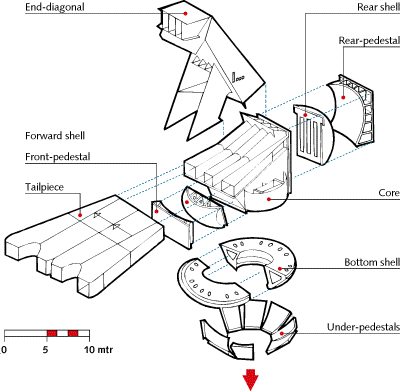



![[animatie]](../../anigifs/104/neigsnel.gif)
Parts ball-joint and foundation

The ball-joint is not a perfect sphere
but consists of various segments of a
sphere or "shell elements": a forward
shell, rear shell and a two-part under-
shell. The steel sphere rotates in ten
cast-steel pedestals: a large rear-
pedestal, a smaller front-pedestal and
eight small under-pedestals. The shells
are attached to the concrete basin in the
foundation by means of steel anchors.
When the gate is being driven in, the
hinge rests with the bottom shell on the
under-pedestals. The sphere is not
pressed into the rear shell until
submersion and the water-pressure
differential is taken up.
Foundation
The hinge-foundation is required to
transmit the immense horizontal forces of
the water pressure to the subgrade. The
foundations consist of a concrete
construction in the form of a wedge of
cake, with an ultimate weight of 52,000
tonnes (520 x 10E06 N). Not a single pile
was used in the construction of this
colossal foundation. Radical soil
improvement enabled the foundation to be
built directly onto a firm, compressed
sand-layer.
The concrete foundation and hinge may be
compared with a soft, yielding cushion.
The subgrade is composed in such a way
that the foundation is able to move by
some 22 centimetres to a depth of 40
metres in the event of a severe storm.
Once the load has eased the foundation
gradually springs back. Allowance is made
for the fact that part of the shift will
be permanent, so that there is a chance
that the barrier will end up several
centimetres closer to Rotterdam after a
severe storm. The amount by which the
barrier shifts permanently will be
greater the first time the barrier is
closed for a storm than later on, when
the sand beneath the foundation has been
compressed even further.
![[animatie]](../../anigifs/104/kuilsnel.gif)
![[photo pit]](images/bolkuilkl.gif)
![[animation]](../../anigifs/104/fundsnel.gif)
![[photo foundation]](images/bolfund2kl.gif)